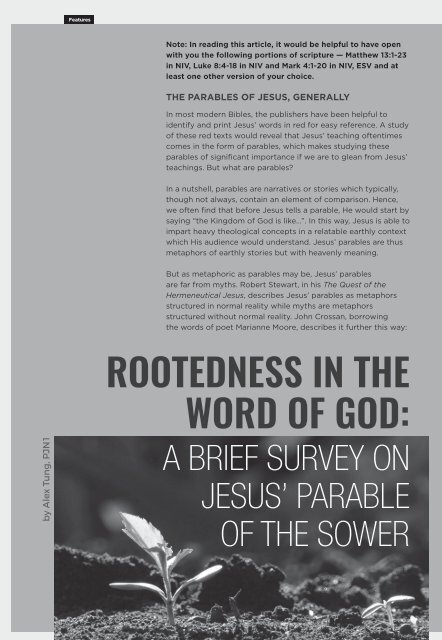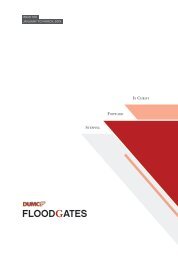Floodgates 101_Issue2_2019_FINAL
You also want an ePaper? Increase the reach of your titles
YUMPU automatically turns print PDFs into web optimized ePapers that Google loves.
Features<br />
Note: In reading this article, it would be helpful to have open<br />
with you the following portions of scripture — Matthew 13:1-23<br />
in NIV, Luke 8:4-18 in NIV and Mark 4:1-20 in NIV, ESV and at<br />
least one other version of your choice.<br />
THE PARABLES OF JESUS, GENERALLY<br />
In most modern Bibles, the publishers have been helpful to<br />
identify and print Jesus’ words in red for easy reference. A study<br />
of these red texts would reveal that Jesus’ teaching oftentimes<br />
comes in the form of parables, which makes studying these<br />
parables of significant importance if we are to glean from Jesus’<br />
teachings. But what are parables?<br />
In a nutshell, parables are narratives or stories which typically,<br />
though not always, contain an element of comparison. Hence,<br />
we often find that before Jesus tells a parable, He would start by<br />
saying “the Kingdom of God is like…”. In this way, Jesus is able to<br />
impart heavy theological concepts in a relatable earthly context<br />
which His audience would understand. Jesus’ parables are thus<br />
metaphors of earthly stories but with heavenly meaning.<br />
But as metaphoric as parables may be, Jesus’ parables<br />
are far from myths. Robert Stewart, in his The Quest of the<br />
Hermeneutical Jesus, describes Jesus’ parables as metaphors<br />
structured in normal reality while myths are metaphors<br />
structured without normal reality. John Crossan, borrowing<br />
the words of poet Marianne Moore, describes it further this way:<br />
ROOTEDNESS IN THE<br />
WORD OF GOD:<br />
by Alex Tung, PJN1<br />
A BRIEF SURVEY ON<br />
JESUS’ PARABLE<br />
OF THE SOWER







